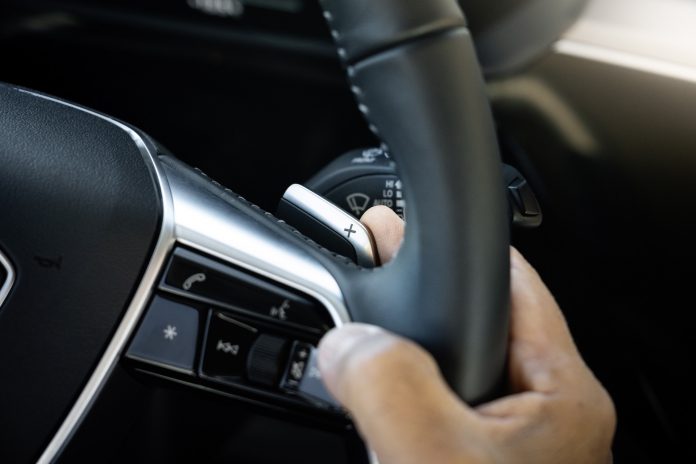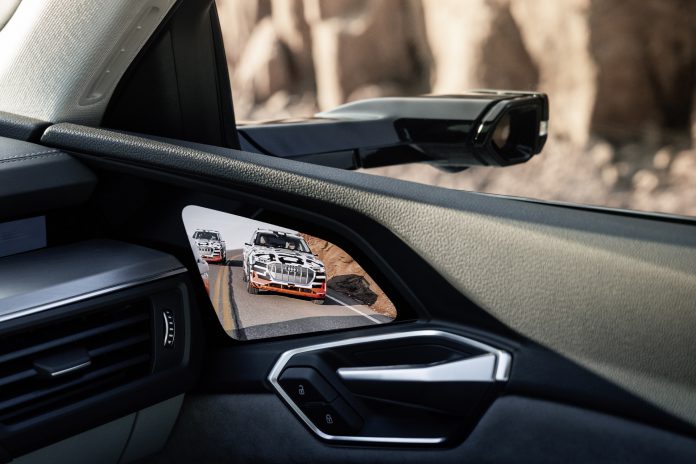The wind is gushing, it is dark and close to freezing outside. It is 4:45am and I’m in a convoy of Audi Q7s driving up the legendary Pikes Peak mountain road in Colorado. The headlights of the Q7 light up the fog covering the mountain at this early hour. But as we approach the top of the mountain which stands more than 4,300 meters tall above the city of Colorado Springs the first faded stripes of dusk start to appear above us.
We came to Colorado to experience the full-electric new e-tron for the first time. Audi is particular keen to show us the braking and energy recuperation system that it developed for the new e-tron. I was very happy I packed a jacket as the wind chill feels well below freezing at the top of Pikes Peak. As the clouds slowly disappear and the sun appears as a little red slice of lemon on the horizon a small pack of Audi e-trons await our arrival.
The Audi e-tron has been teased and shown a couple of times as concept car and prototype so I have grown quite familiar with the shape and looks. It is sized roughly between the Q5 and the Q7 but its outer appearance is closer to the A6 Allroad than the suv models. The dropping roofline gives it a sporty appearance.
On the inside the new e-tron looks a lot like the new A6, A7 and A8 with a few differences. There are touch screens all around including even the climate controls in the rear. Overall I really like the recent Audi interior designs, very sleek and cutting edge. Although I haven’t been a fan of touch screens, with the haptic feedback it works very well.
Thanks to the purpose built electric platform there is very flat floor throughout the car providing ample space for passengers and luggage. The rear passengers sit slightly higher than the driver which gives them a better view without me (being 1,90m) suffering any lack of headspace. Under the front bonnet there is a small compartment that fits a small bag or the charging cable.
Power is provided by two electric motors; one mounted on the front axle providing 125 kW and 247Nm of torque and one mounted on the rear axle providing 140 kW and 314 Nm of torque. A special S mode allows a temporary boost of the complete system output to 300 kW and 664 Nm of torque. Enough for a sprint from 0-100 km/h in less than 6 seconds.
But it is the ability for the e-tron to recharge or recuperate energy during parts of a regular drive cycle that plays an important role for the e-tron’s 400 km+ range on the WLTP cycle. At Pikes Peak I join head of the brake development team in a pre-production prototype to see and feel the various ways the e-tron can extend its range by using the available heat and energy.
The 31-kilometer long Pikes Peak road gained worldwide fame and recognition for the annual hill climb race which was won this year by Volkswagen with a full-electric race car concept while also setting a new all-time record. The road covers a total height difference of over 2,000 meters and features over 150 corners.
The e-tron being all electric does not have a normal gearbox as we know it from petrol cars. Yet there are two paddles behind the steering wheel. They give quick access to three different driving profiles. The first one is coasting let’s the e-tron roll with as little resistance as possible. Energy recuperation is limited to only when you press the brake pedal. The second profile is gradual deceleration; when you lift the gas pedal the car slowly decelerates using the electric motors to regenerate as much energy as possible. The last profile is high deceleration and provides up to 0.3 g and 300 Nm of braking performance through the electric motors. This allows for one-pedal driving as the car slows down to 0 when you release the throttle. This will fundamentally change the way we are used to drive.
The latter profile also allows us to go down hill with hardly the need to brake for the corners and at the same time we can see the battery charge go up significantly. Once you press the brake paddle past a certain threshold it automatically applies the regular brakes which also are also capable of recuperation but provide additional stopping power needed for emergency stops. Other electric cars use similar technology but Audi has added some refinement and re-engineered parts to create what they claim is the most efficient system to date. In short it adds up to 30% range per charge and improves braking performance by 20%.
Besides the manual choice of driving and efficiency profile there is also an automatic mode that also factors in navigation map data to adapt the speed and level of recuperation. A range of assistance systems will be available for the upcoming Audi e-tron including adaptive cruise control, lane assist and my personal favorite: two digital mirrors. The mirrors are replaced by sleek cameras on the outside and two displays on the top inside of the doors. The camera virtually eliminates the black spot and can be easily adapted by swiping the touch screen on the drivers side. The digital rear mirrors should become available as optional extras as long as it is allowed in the country you live in.
Having electric motors at the front or rear axle allows Audi to emulate a quattro system which can send up to 100% of the power to the front- or rear wheels. A torque vectoring like system is provided by braking the inside wheels in a corner. Nearly 100% of the torque is available immediately giving the e-tron an explosive character from standstill. At higher speeds there will obviously be a trade-off between speed and range.
Overall the Audi e-tron is a very welcome addition to the market of electric cars. A cool but not overly expressive exterior is combined with a cutting edge and luxurious interior. Whereas Teslas feel under-engineered the e-tron is the exact opposite and my first impression is that it makes for an excellent daily driver and travel companion. It remains to be seen though what kind of range we can expect with a regular driving style.



















































